From Expansion Packs to DLC: The Evolution of Additional Video Game Content
Downloadable content – or DLC – has become a mainstay in the video game industry. Now, every high profile game is expected to have additional content roll out over the months that follow its release. New games for PC, PS4, and Xbox One generally carry a price tag of 59.99 USD, and additional content requires players to pony up anywhere from 5.00 USD up to 25.00 USD to purchase extra content. The video game industry, like any other, is business oriented – profits mean that a game company can continue to produce content. Purchasable additional content for video games can be traced back to its initial inception in the early 1980’s with Dunjonquest: Upper Reaches of Apshai. In the mid 1990’s, expansion packs became increasingly more viable for companies and more appealing to gamers, paving the way for the current trend concerning DLC on both PC and consoles.
There are some who see a problem with the current trend of DLC. Many believe that some methods are exercised to purposely release watered-down products – having DLC already in mind to fill in the holes – a nefarious attempt to gouge customers past the initial purchase of a game. Drawing a path from past PC game expansion packs to the present state of digital content sheds some light on the positives and negatives additional content has had on content, consumers, and the gaming industry in general.
The Emergence of the Expansion Pack in Mainstream Gaming
So what is offered in typical downloadable content exactly? Depending on the game, it could be new characters, items, areas or game modes. Expansion packs of old included most, if not all, of the above. One way to understand the evolution of DLC would be to go back and examine expansion packs that hit PC gaming in the 1990’s.
Picture what media was like back in 1996: Tomagachi’s, the Spice Girls, VHS tapes and dial-up modems that now seem ancient compared to the high-speed internet of today. Back in the 1990’s, people played their video games predominantly on Super Nintendo, Sega Genesis and then later on Nintendo 64 and Playstation. These game consoles did not have internet connections, therefore the games you bought remained in the state they were released in – meaning their initial update version would last for each particular game’s lifespan – in contrast to the almost weekly updates some games get in today’s industry. Not only did console games in the 1990’s receive no patches, the content remained unchanged as well, what you bought was the final product. For PC gamers of the time, updates and the like were available, but the internet of the 1990’s was not the internet of today. Services like Amazon and Ebay were still in their concept stages, it took the arduous act of actually taking a trip to a computer store to get additional content, and that extra effort in contrast to today’s accessibility meant that expansion packs for video games needed to have sufficient content to warrant a purchase – it couldn’t just be a few new maps or a makeover here and there.
Blizzard Entertainment is one of the popular companies known for their expansion packs, a prime example of what additional content was doing for the world of PC gaming, and by analyzing what worked and what didn’t concerning expansion packs of the past, a picture of the present state of DLC emerges.
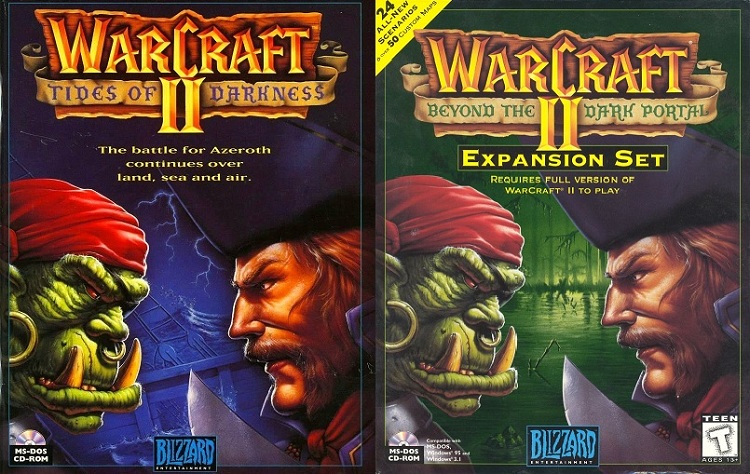
One of the pivotal instances of additional content in video game history came to the PC in 1996 with Warcraft 2: Beyond the Dark Portal, an expansion pack to the acclaimed 1995 Warcraft 2: Tides of Darkness, beginning a successful trend that would carry through into the future of Blizzard’s catalogue. The Warcraft series is a staple for Blizzard, and has helped in their rise to become the big name brand they are today. Before their massively multiplayer game World of Warcraft, the series was a RTS (Real Time Strategy) game. Warcraft 2 was known for its rich gameplay and graphics for the time, as well as its lengthy single player campaign and easy-to-use map editor. The charm and atmosphere of the game was also a staple, due to its art direction and voice acting. What hooked most gamers, however, was the online aspect of the game – one of the first that caught on with the budding PC multiplayer scene.
An initial review by Gamespot of Warcraft 2’s expansion pack shows that it was well received upon release: “More challenging and more diverse than its namesake, Beyond the Dark Portal proves once and for all that you can never have too much of a good thing.” Indeed, Beyond the Dark Portal is a prime example of additional video game content doing exactly what gamers should desire from an expansion pack. It features a more grisly campaign, and most fittingly continues the story of the main game in a meaningful and interesting way. Should this not be the goal of additional content? A memorable experience that builds upon the original game? This expansion pack began the trend of including a tighter story and hero characters who carried the narrative of the single-player campaign, a signal of what was to come in future additions to Blizzard’s series.
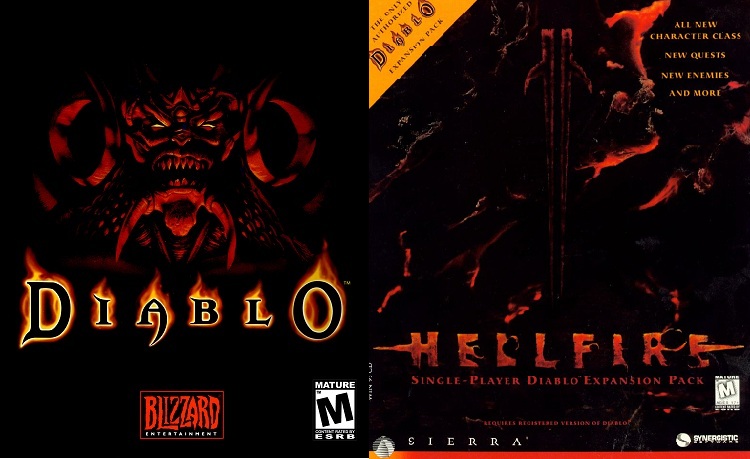
Blizzard did not become a premiere video game company on the back of Warcraft alone. Before the introduction of Starcraft, their other series in the mid 1990’s was Diablo, which completed a gruesome twosome that propelled Blizzard to their top status. Diablo, like Warcraft 2, was incredibly popular – especially due to its online community Battle.net – one of the first in the world of video gaming that Blizzard still operates for its catalogue today.
Eventually, Diablo had an expansion pack released for it entitled Diablo: Hellfire. However, it was not developed by Blizzard itself, instead it was commissioned to a third party developer, Synergistic Software, and published by Sierra On-line. In other words, Blizzard outsourced for this expansion pack – but do be fair, they were busy making what would become one of the greatest sequels of all time in Diablo 2. Nonetheless, the lack of Blizzard’s personal touch concerning Hellfire was felt to detrimental effect.
Probably the most criticized move concerning Diablo: Hellfire was the lack of a multiplayer element. As stated, this is one of the most popular aspects of Blizzard’s games. Diablo’s multiplayer is what made it endure for many years, and while Hellfire is a treat for single player enthusiasts, in the grand view of the series it has been mostly forgotten. This is in contrast to Beyond the Dark Portal, which is seen as a must-buy for players of Warcraft 2, while Diablo: Hellfire is seen as expendable, a side entry that can be passed over. While Blizzard would continue on to make well received expansions to Warcraft 3 and Diablo 2 – expansions that would stand the test of time – the misfit Diablo: Hellfire serves as an example of superfluous additional content, and a sign that even at a time of great expansion packs there were some viewed as anything less than.
Blizzard Entertainment and its catalogue are not the only example of popularizing the trend of expansion packs. Valve Software is also known for their numerous instances of additional content for their influential game Half-Life, released in 1998. Half-Life changed the face of FPS (First Person Shooter) games – subsequent iterations in the genre would borrow heavily from its seamless gameplay and narrative. Half-Life however is known more for the plethora of modifications created for it rather than its expansions (fan-made entries that used Half-Life as a base for their own creations.) One most notable mod was Counter-Strike, which at the time of its release was a free fan-made game, becoming one of one of the most played online games along with Diablo, Starcraft and Warcraft. Counter-Strike was so popular it landed its creators Minh Le and Jess Cliffe jobs at Valve, and because of the title’s success, Valve Software would end up releasing a game changer of their own, similar to Blizzard’s Battle.net.
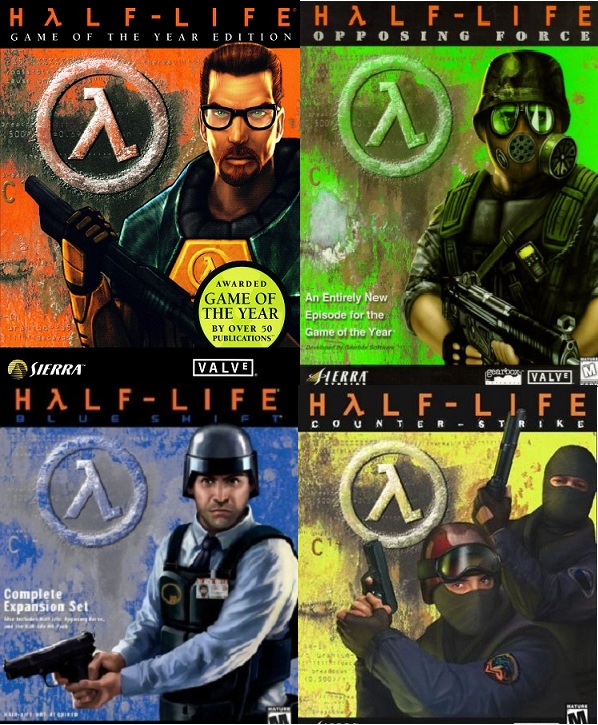
The Rise of Digital Content and Distribution
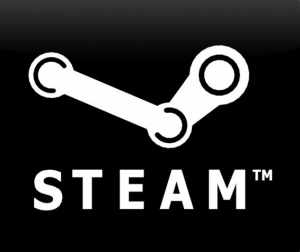
In 2003, Valve released Steam. Before that, Counter-Strike’s native server search engine was cumbersome and insufficient. Most players would use third-party programs to obtain more complete server lists (rooms to play online with other players). Steam was an answer to this problem for Valve, allowing players to use an official program instead of unofficial ones such as Gamespy Arcade or the All-Seeing Eye. This gave players more streamlined access to search for servers, but this was not the only goal of Steam. It was also created to heighten the anti-cheating software for Counter-Strike and give players an easier way to download updates, thereby doing away with having to search the internet for a suitable download link.
The requirement of using Steam was a big change for many players accustomed to their particular ways of finding game servers for Counter-Strike. Because of this, Valve added an incentive to get players to hop aboard the Steam train. Counter-Strike’s pivotal 1.6 update was released exclusively on Steam, adding touches to popular levels, and most importantly adding new weapons to the game. The smoother interface of Steam – in conjunction with providing exclusive access to Counter strike 1.6 – was enough incentive to get the majority of players to try Steam out. On top of this, if a player had a CD-Key (proof of purchase) of a Valve game – say the original Half-Life or the CD version of Counter-strike – Steam granted access to many other Valve games such as the expansion Opposing Force or the multiplayer Team Fortress.
Eventually the user-base for steam grew, especially once the release of Half-Life 2 was on its way. In August 2004, Valve began open beta testing through Steam for their new Counter Strike: Source, a sequel to the original Counter-Strike. This is a crucial instance to take note of, as Steam was the only way to play this open beta, as well as the only way to play Half-Life 2 once it was released – a restriction that was the start of a new practice – nowadays considered common for a high-profile release. Valve’s release of Half-Life 2 along with the mandatory use of Steam was met with some friction upon the game’s release date in November 2004. Steam allowed users to pre-load the game before it released, and most gamers bought the digital copy over Steam. For some, it was the first digital purchase of what would become many.
The trade-off with this new practice was being able to purchase and obtain the game from the comfort of your own home, but in doing so you forgo not only the physical copy of the game in the form of a CD – but also the case, the boxart, instruction book, and any other items like maps or artwork. Some customers had issues on release day concerning their connection to Valve’s servers, which despite much preparation, were nonetheless overloaded. Despite the negatives, the release of Half-Life 2 through Steam would be a landmark for digital distribution in video games – a bit of a gamble at the time for Valve, but a gamble that would pay off for the company, as Steam would become the model for digital distribution henceforth and the new way for many PC gamers to purchase titles.
What does this all mean for DLC? This ease into an increasingly digital method of distribution coincided with the rise of high speed internet connections, and Steam became a model for many other game companies afterwards. Content became more streamlined, which on paper is all well and good, but purchases of this sort are tied to your Steam account, not a physical copy that some find more secure. Half-Life 2 brought about the shift from using cd-keys to the proliferation of steam accounts, a move that meant purchases would become tethered to Valve’s revolutionary distribution tool.
The Present State of Additional Content
The current trend of DLC coincided with the release of the Xbox 360 and Playstation 3, a parallel to the rise of high speed internet. Like Steam’s platform for digital content and delivery on PC, Microsoft and Sony had a similar service for their respective consoles – a more premium, streamlined service. Also, the more jaded view of contemporary DLC coincides with this distribution and subscription trend that the video game industry has taken on.
Bethesda Softworks’s The Elder Scrolls IV: Oblivion and its “Horse Armor” pack is a prime example of the contemporary backlash towards DLC. It is the first widely covered example of purely cosmetic additional content, and while it was only a few dollars to purchase, for many gamers this has become a growing issue, going against the old idea of additional content being something that builds upon the original experience, or at the very least something that adds substance. To be fair, many of Bethesda’s released DLC packs fit this criteria of what should make a good expansion pack, but Oblivion’s horse armor has become the poster child for those that scorn DLC, using it as an example of the frivolity in additional content.
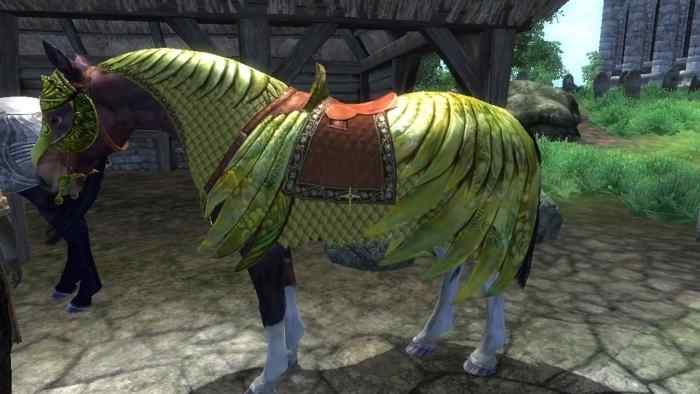
Again, this type of content would of been an exercise in futility back before digital delivery, being offered for free if even released at all, but with the increasing accessibility on both PC and consoles, it became much easier to simply open a menu in-game and pay the few dollars it took to purchase, a sort-of impulse buying that was largely unseen before Steam, Xbox Live and other services of their nature. This increased symmetry between consoles and PC came about due to their use of digital distribution, making it possible for video game companies to get their additional content to more gamers, across more platforms – quicker then ever before.
While Bethesda has been ridiculed by some for their “Horse Armor” DLC, Electronic Arts, or EA, has been outright vilified by many for their practices concerning additional content. EA took the Steam model and used it for their own distribution service entitled EA Origin. Like Steam, it offers an online marketplace to download titles offered by EA. What many dislike about EA’s implementation of Digital services is their exercise of offering season passes for their games. These season passes cost as much as the game itself, allowing you access to all the DLC that will be available for that title – in effect paying for content that has not been released yet. Many cynics harp on Electronic Arts because of other things as well, such as while one of their titles is still in development, they already have paid DLC in mind – which some see as undermining their costumers. In other words, jaded gamers see EA releasing a watered down product at full price, then offering the content that should of originally been included at a separate price shortly afterwards.
Another big title released by EA in 2016 was Star Wars Battlefront, a game that features top graphics and nails the style and sound of the Star Wars universe pretty well – yet many have had problems with it since its release. Some criticized the lack of a single player campaign, while others felt that to fully enjoy the game they needed to dish out the extra 59.99 USD for the DLC season pass, feeling even more jaded once the announcement of a sequel was made mid-way through the current game’s season. This goes against what additional content should strive for, not something that completes the original game, but something that builds upon that initial, satisfying experience.
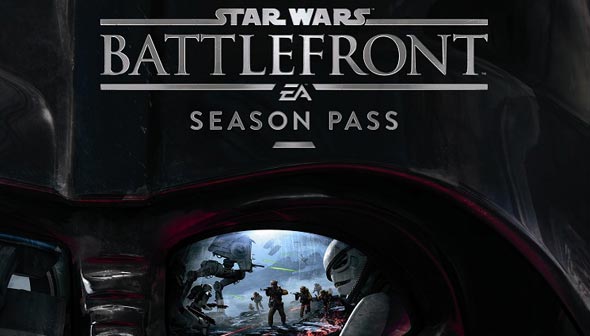
While the old moniker “buyer beware” should definitely be used against those who see a problem with this business model that EA has taken with DLC, it still bothers many that the industry has turned this way. A more egregious example in yet another EA game would be Dragon Age:Origins, where the in-game characters pester you to pay for additional content, content that was already contained within the initial release but was blocked off for paid DLC purposes. EA isn’t the only company in the sights of many gamers with a chip on their shoulder – Capcom has had similar complaints over the release of Street Fighter V. While criticism is thrown at companies that pre-plan DLC for their titles along with the implementation of season passes, the truth is that the video game industry is still a business after all. DLC makes an astounding amount of money for companies. For EA, it is arguably more profitable than the game itself. This increasingly negative attitude toward DLC and these issues over season passes and on-disc content being locked off for future payments is not a complete picture of the current industry however.
As mentioned previously, despite the lampooning of The Elder Scrolls 4’s “Horse Armor” DLC, Bethesda is nonetheless known for their quality additional content for their games, add-ons that go back to the roots of what should make extra content satisfying – something that builds upon the original game, or at the very least gives something substantial enough that warrants its inclusion, not just a new weapon or a new skin that brings little change. CD Projekt’s The Witcher 3: Wild Hunt is a recent example of a game whose DLC packs are highly praised and embody this picture of what additional content should strive to be. Many see the recent release of The Witcher 3’s “Blood and Wine” to be a contender for Game of the Year – despite being just an expansion pack. What this shows is that the current landscape concerning DLC should not totally be condemned, but like any other service or product, a consumer should be aware of what they are paying for and what to expect from a certain company.
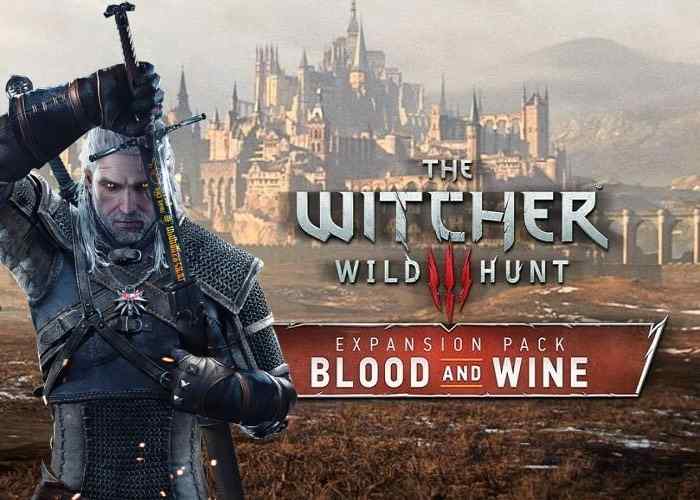
In the End it is About the Good, the Bad, and the Ugly
This particular look at the history of expansion packs and DLC comes to the conclusion that digital distribution is the pivotal cog in understanding how a video game’s additional content is packaged and sold to fans. Like any revolution, the digital age has its pros and cons. Anyone with a good internet connection now has the ability to purchase and download a title on release day. Good expansion packs like those for the older Blizzard games on PC are not things of the past as some would think – The Witcher 3: Blood and Wine being an example of that – yet the marketplace is filled with an over abundance of frivolous offers that many see as a detriment to the entire industry of video gaming, a shallow cash grab from a cynic’s point of view. Overall, what the history of additional content for video games has shown is that it is not the distribution abilities that is the pivotal aspect to what makes additional content worth it or not, but whether or not the time and care was put into the project. Because of the high profits being made currently, this practice that the majority of game companies follow concerning downloadable content will continue on without any major changes. Gamers should demand that additional content be something that thoroughly expands on the initial experience of the original title, and perhaps most importantly these additions must show that the makers respect their fanbase.
What do you think? Leave a comment.





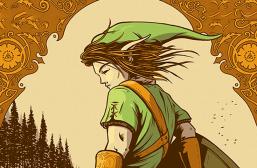





To be fair I am ok with DLC, but only if it’s really a meaningful add-on, just like expansions in the past (Think the Baldur’s gate or Neverwinter nights expansions, for example), not some extra skins and BS or just a part of the game that should have been included in the vanilla game in the first place…
I think that if companies want to make a profit, it should be by releasing decent games… not shitty products and scam the gamer.
Companies who release bad games or games with half the content missing for full retails price and thus cheat the gamer deserve to go belly up.
Games should be complete and good when released. Then of course they can milk us for extra bits, if they want.
I agree with you Jinny but sales trends are showing that gamers will still buy games in their current (unfinished) state for various reasons. Until gamers start voting with their wallets companies won’t follow suit. Hopefully with the rise of eSports this will happen sooner rather than later.
I miss the days when you would boot up a game on your old system and it has everything on the disc.
Were there really full and complete games or did we just dream that, that’s what it feels like nowadays, I actually feel privileged to have grown up when gaming was starting out, I’m not saying I miss playing games that looked like moving squares and triangles, but the principle of games for gamers was sound, I miss that too.
Here’s how to put a stop to this:
1.Stop buying games with micro transactions and day one DLC to make up for the 12 year olds who use the parents credit cards to buy this crap.
2. Stop defending and supporting games that have micro transactions and day one DLC, this just tells them it’s okay to do this.
3. Buy it used if you must play the game so they don’t get any money from you so they can accept that they’re games would sell better if they just sold complete games.
4. Let’s kill this trend before it’s to late.
Gaming is dying, no-one cares anymore. Just get the N64 out and play Goldeneye.
It definitely feels like a shifting landscape these days. I’m always excited to see a change in the video game market. Wonder what will work out and what’ll end up going the way of the virtual boy.
I am 40 years old. I remember myself buying games on a 3.5 inch floppy disk. I never thought, “wtf, they sell their product?”. This industry, was not industry i think. It was nerds, passionate ppl, innovative ppl, gamers with imagination. It was like Philosophy is, if you told ppl you want to create PC games, ppl would tell you it does not pay well. Who artist really cares about money? None, none that is who is honest with himself.
Just research history. Where Advertisement started, reach to the point how Advertisement is teached in Universities. How they try to exploit naive consumers. It all adds up for ppl who research a bit i think. The micro-transaction is a greedy twist, not an evolution in gaming. Similar to what Capitalism became, a weird, non humane, evil twist of itself. So, the endgame is, they sell as long as there are uninformed ppl willing to buy things they don’t actually need.
I think ppl should be able to separate what is worth buying and what is not. Example, Fallout is a game that does not need advertisement. A gamer will buy this shit because it is worth it. Then, look a game let’s say like World of warships. For ppl researching the modern gaming industry, you would know the time and effort these Devs put on Marketing and not the developing of the game really. Fallout, no need for advertisement. Worthless shit, tons of advertisement and marketing. Micro-transactions do not belong in a healthy gaming community imo.
Even South Park went ahead to debunk literally the whole process of consumer exploitation with an episode. I believe western societies should move legally against many of these companies.
When you mix art with business, the results are always the same. Video games aren’t made for the same reasons they used to.
Pre-order and DLC have become poisoned terms. DLC is a great way to get more out of your game while pre-orders secure your own copy of the game with a sweet bonus on the side, but publishers have exploited the shit out of these two practices!! Evolve, Battlefront EA, Metro Last Light, Assassin’s Creed, and Deus Ex just to name a few!
I paid 60-80$ per game in the SNES era. My earliest jobs in middle school and high school went to this.
Ive recently gotten irritated at the current generation of gamers who (because of a few bad apples in the gaming scene) assume that games are going to be shit just because they have dlc. I have friends that literally say they think games coming out this year are bad because of dlc, but then they dont understand half the shit. The word DLC has literally become a label for “that game is shit, end of story”. THAT PISSES ME OFF.Just because a game has dlc does not mean its going to be shit at launch.
A lot of game purchasers are young and not able to watch out for themselves properly in a free market, and so they get taken advantage of. It’s been a problem ever since children came to be targeted by advertisers and sellers. Worse, those purchasing games are at a key demographic that falls between too young to buy things on their own and old enough to know better, so this is worse than it was back when it was mainly toys and console games. I think the only solution, if this problem is to be solved at all, is to enact legislation to protect the consumer from predatory sellers.
it’s because the gaming industry is greedy and all they care about is money
The developers need to make an effort to produce higher quality, and more consistently too.
I don’t even bother with DLC altogether. I just ignore it.
This. I’ve haven’t played games that put important things behind a pay wall though. That is why I stay away from the “free to play” crap.
I thought this was a great article. One trend that I don’t really see happening so far, but would like to, is high-end games aimed at those older gamers who now have kids and jobs and as such can only spare a few minutes at a time to play high-end games on consoles / PC. So many games now require hours to just get into and really start the game and that just doesn’t work for my demographic.
You could open Steam and have a browse. Lots of crap, but plenty of indie games suitable for casual gamers.
I am fine with dlc as long as it is good dlc with good content but most importantly keep full content of game within a reasonable price point. No matter how good a game is I can only play for so long before I am bored with it and I equate value to time it keeps me entertained.
Developer puts out DLC and Season pass people complain. Developer doesn’t put out DLC gamers yell “where is the DLC” or “I want additional DLC”. Really no way for developer to win.
Huge difference mate, look back at when DLC first became a big thing. The DLC expansions or add-ons were awesome and added NEW content to the original game. Today’s “dlc” is skin packs, boosts, lottery card drops (halo and blops3). When someone asks for DLC they want more game content. Look at dying light coming up with the following. That is one hell of an expansion of the witcher 3.
Transactions, content pulled from the original game and sold back to you, day one DLC, skin packs and customizations are all the crap that is wrong with today’s gaming.
I’m probably the only one that’s fine with all of this.
They milked and knickled n dimed us with dlc. I have enjoyed fully one game this entire generation. Bloodborne.
When i was a kid a game for my computer cost £8 – 12 then sega came along and it was £ 40 and then the first PS1 games i bought cost £60.
All my classic games (Sly Cooper, Ratchet & Clank, Jak & Daxter, and infamous) were the reasons of why I was with Sony (and with a few multiplatform games). But now it’s just not grabbing my attention anymore. Most of these games had not kept my eye cause of this.
I would rather spend 80$ for a quality game without micro transactions and DLC.
My friends and I thought a gaming crash was going to happen during the PS3/Xbox 360 era. With games costing more and more, all it would take is one big failure to put a major company out of business. DLC’s and microtransactions stopped that from happening. But eventually the game budgets will adjust for the profits from DLC’s and microtransactions by having bigger budgets. When that happens it could lead to another potential crash situation.
Why is putting out an incomplete game the *thing* now? Take the Sims for example: $60 for the new game and it’s always a given that you’ll have to buy expansion packs to diversify game play because, let’s face it, the base game gets boring as hell after a week or two.
Some DLC is definitely ‘worthless’, unless purely aesthetic components are a crucial element of your gameplay, but I find a lot of the Dragon Age DLC to be essential to rounding out the story.
I think you hit the nail on the head with “there is good, bad, and ugly.” DLC at its core is good, but can obviously be used for nefarious reasons like what EA did with Battlefront. I think DLC becoming a reason to water down games only emerged with this newest generation of consoles. It was at its peak (for consoles) in the previous generation. Titles such as Fallout 3, Halo 3, and Dragon Age Origins come to mind for me when I think of DLC done properly. All of these titles offered a complete and rich gaming experience upon initial purchase with DLC coming out much later to further the life of the game, adding to the already whole value of it rather than complete it as some more modern games do.
Great post Jeffery. I want to point out that DLC for multiplayer games often include “map packs”, which can really negatively impact games. Sure, getting new areas to play in is rather exciting, but at a price of $10-$15, the player base of a game can become segregated. For instance, if two friends purchase a game for $60 on the day of release, they are able to get into a map rotation that they both have access to. But down the road, the developers release new maps for a price that one friend is willing to pay for, but the other is not. Here we see another “ugly” side to modern DLC as players can become easily segregated for financial reasons.
Great Article. I think that DLC is a huge issue/area of importance in today’s video games community. Your article was very insightful, it was interesting to see how add on packs and DLC have evolved throughout the years.
I think that there are many good examples of DLC such as Witcher 3: Blood and Wine, but one of the dangers of DLC occurs when companies are not transparent enough with what is included in DLC offerings. For example, Warner Bros Games initially did not tell consumers what would be included in the Batman: Arkham Knight DLC package. This let to some deserved backlash.
I think the important thing is that companies should inform their consumers of what is included in DLC so that they can make an informed purchases and understand what they are buying.
This is a strong article. I am frustrated by the way in which gaming companies are limiting their developers and user experience by planning with a DLC/continued revenue model. The worst part is that they are devoting manpower to developing these aesthetic-type DLC content packs instead of trying to figure out how to improve and expand the user experience.
Bungee’s “Destiny” released with loads of hype, and I even took time off of work to immerse myself in the game. After a few days, I realized that the story had been snipped and cut from it’s original make-up. Instead of the story we were promised, Destiny delivered a shooter that recycled the same levels and mission landscape over and over, turning the entire game into a headbanging loot-grind. As it turns out, Bungee stripped much of the story away in order to release it in future DLC. The game we expected to get for $60 actually costs about $120 when all is said and done. Bungee continues to improve and expand the game, but I wish they would do so through traditionally expansions instead of weak DLC.
I’ve never been a fan of DLC but only because after buying the $60 game I have no desire to spend more money on an addition I’ll only play for a day or two at the most. I should mention I’m a story>multiplayer type of gamer and once I finish a games story I rarely touch the multiplayer.
I think when it comes to narrative based games in particular, it all depends on whether the DLC content is heavily related to the main story or if it’s a separate adventure unrelated to the main game. For example, in Mass Effect 3, Javik should’ve been included in the main game. We’ve known about the Protheans since the opening moments of Mass Effect 1, yet the only way to actually interact with one is to either buy the Collector’s Edition or pay an additional $10 for the DLC separately. In contrast, I think the Jack the Ripper DLC in Assassin’s Creed Syndicate was worthy as DLC. While people know about Jack the Ripper and are interested in seeing how that story plays out, Jack the Ripper’s story has nothing to do with the main game. Not only that, but the DLC takes place 20 years after the events of the main game. People will most certainly disagree with me, but that’s my thoughts on the matter.
There are a lot of excellent points you bring up, on both sides of the argument. The paragraph where you wrote about older games being stagnant due to the lack of additional content was most thought-provoking. It brought to light why having DLC is so important in games these days, for without it, most games, especially online multiplayers, would be played for a couple of months at most.
With that said, it is rather obvious that some companies are going overboard with the concept of DLC. I remember when games like Halo and Gears of War, would only charge for early access, first thirty days or so, then release the maps to the general public later. Someone mentioned in an earlier post how this segregates the community because only those with DLC have access to certain maps, areas, or items.
The price of games have already went up from $49.99 to $59.99, and DLC is following suit. First and second generation console games had DLC that was $20 most, and that covered everything. Now for some games, that covers the first DLC, while others have DLC for $50 and up. So now for a player to enjoy the full experience, they essentially have to buy the game twice.
One point to remember with all of this, is that a lot of this falls on the publisher. Games, especially good ones, cost a lot of money to make, and developers don’t see as much of the profit as you might think. Like all problems regarding what customers deem “too expensive” product, the companies need to do some serious introspection. I agree with DLC, but not on the current track it is on.
This article is very on point. DLCs that come in the form of season passes like in Star Wars Battlefront are what’s ruining the game industry. It cost an additional $50 to get the season pass, and is an excuse for developers to release unfinished products
This article explains the issue very well- that DLC is a great way to enhance the original content but it can be a slippery slope to watering down the base games, which can cost $60 or more.
It’s interesting to see the development of DLC over the years but really does highlight the decline of the gaming industry all round, good job.
I think that you did well expressing what exactly is right and wrong with the concept of DLC. On paper, it seems great that you can add extra content to a game, but when you have to pay for something that doesn’t seem like it warrants payment, it seems like a money grubbing scheme conjured up by the developers. It doesn’t help that some companies like Capcom have the content in the game itself when they easily could have just made them unlockables in the game. I just hope that publishers are smart enough to know what warrants as being DLC and what doesn’t.
If only more companies would follow CD Projekt Red’s example.
Sometimes DLC can be a great way of adding more content to a game you love, allowing you to enjoy it even more than before, but sometimes it’s just an obvious cash grab, and I fear the latter is becoming more common. There are some games that still release amazing DLC, but some games such as the Call of Duty franchise that charge upwards of 15 dollars for a couple new maps seems silly to me. I hope that gamers will continue to protest meaningless DLC, and I hope that developers will make meaningful DLC that will add new elements to games that we already love.
DLC and addon packs are, to say the least, disconcerting. I find myself missing the days when spending $50-60 left you with a game. A complete, polished game. Now, it seems you spend that same amount and are met with glitches, bugs, faults, and a blatant lack of content. $60 and you have to wait for the day one patch, countless other hotfixes, and you’re still almost guaranteed to run out of content in a week… Unless you buy the downloadable content. Buy the season pass for anywhere between $20 and $60 (the price of another game!), and you can have some stuff. Maps, skins, characters, gun camos, etcetera. What happened to quality expansions and content?
Blizzard’s expansions for World of Warcraft have been successful forms of additional content. Although not all have been successful, they are not only relatively affordable, but they change the game — they add content, further the story, give you something to do that doesn’t involve skins or patterns. It seems few games have adopted similar policies with their expansion packs and DLCs. Rainbow Six Siege has, perhaps, one of the less obnoxious DLC platforms. Sure, you can buy the season pass to unlock the new operators a week before everyone, but you can save your real money and simply play the game, earn in-game currency, and unlock the same characters. This, plus free new maps and continuous updates.
While additional content can be new and exciting for the right game, it rarely is. It’s a dreaded “Do I really want to spend double for this?” And if you don’t, you’re left with a title that will more than likely be exchanged for something else. DLC and expansions would be great if they added actual content, exciting and worthwhile content, story progression, new modes, new adventures.
Do not forget the Crusader Kings 2. This game is bigly successful at DLCs.
I would contest this, considering the total cost for all of Crusader Kings 2’s DLC is $449.05 AUD. Though Paradox often create meaningful additional content, their prices are unjustifiable; Crusader Kings 3’s recent Royal Court expansion is almost the same price as the base game yet its content (understandably) pales in comparison.
DLC needs to be priced in relation to the content it offers and should never undermine the price of the base game.
DLC, while a great source of generating a greater return of investment can be troublesome. When we consider the fiscal impacts of gaming and the DLC of certain games it is not only sequels or additional maps, characters and gear. Now games are coming with season passes, so gamers are not being hit with a double price tag unless you score some sort of deal before the release of a new game and pay a heft sum of money to secure the DLC and the season pass. Unless you are a hardcore gamer, I do not see the value added benefits in season passes.